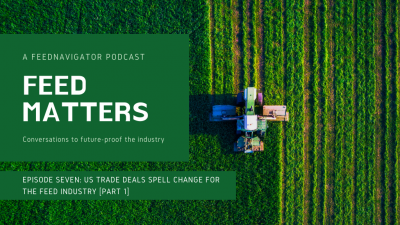Reports from IPPE
AFIA looks to feed industry interests in legislative watch list
John Stewart, manager of governmental affairs with the American Feed Industry Association (AFIA), told us about some of the group's legislative priorities during the International Production and Processing Expo (IPPE) in Atlanta earlier this month. “One of the challenging parts and also the beautiful parts about trade association work is that you often have folks who have a different perspective, a different interest and we’ve got to make all that fit together and we’ve got to make that fit what’s actually happening in Congress.”
The effort involved means that the AFIA works with a wide range of issues relevant to industry members, including regulation, compliance with the Food Safety Modernization Act (FSMA), trade negotiations and efforts to streamline feed ingredient approvals, he said.
“Our top priorities at AFIA, we have two, one being the US Mexico, Canada Agreement (USMCA) … the other is the animal food and ingredient review and approval process at the Food and Drug Administration,” he said during his presentation.
Trump administration actions and the feed industry
In addition to the passage of the 2018 US Farm Bill and the renegotiation of the trade agreement with Canada and Mexico, the ongoing tariffs on steel and aluminum and the trade tensions are an area of administrative action that the AFIA is following, said Stewart during a presentation at IPPE.
“There’s been a focus on regulatory reform and rollbacks and I think we’ve seen some of that,” he said of other efforts the Trump Administration has been taking. “Unfortunately the things that were beneficial for agriculture kind of got stymied a little bit in the government shutdown.”
Alterations in tax policy also brought some changes for agricultural producers, and the discussion around immigration remains of interest, he said.
Currently, the approval process for new feed ingredient can take several years and the estimation is that producers lose about $1.5 to $2m every year in potential revenue, said Stewart of another legislative priority. However, the AFIA is working to improve the process and has already been successful in addressing some conflicting legal language involved in the process.
“We know when you really get down to it they simply don’t have enough folks at the Center for Veterinary Medicine to do these reviews and part of that will be new appropriations for the Center of Veterinary Medicine and in particular for their animal food ingredient review process,” he said. However, that call for additional funding looks to the 2020 appropriations process.
Farm Bill implementation, USMCA ratification
In 2019, some of the legislation focuses for AFIA include work with the implementation and appropriations for the Farm Bill, Stewart told us.
“There are two kinds of separate entities that have to come together to make this work,” he said. “For the animal food industry, and AFIA in particular, we’ll be looking at animal health priorities – we worked with a broad coalition of other partners in Washington and other animal health organizations to express the need for some additional resources to treat and prevent illness in animals.”
The process included looking at work with vaccine banks, and addressing responses to the potential outbreak of animal disease, he added.
Another part of the focus is having the implementation of aspects within the legislation “follow the intent of Congress,” said Stewart. How the US Department of Agriculture (USDA) proceeds during this process is of specific interest.
“Sometimes that’s difficult with the way that legislation ends up being finally written and printed – sometimes there are some challenges around that and that’s where it’s up to USDA to reach back out to Congress and to get some industry input as well,” he said. “It’s also up to industry to make sure that those programs are being articulated correctly, and if they’re not, to find a pathway for how we can connect all those dots.”
Trade promotion also was part of the legislation and continues to be a priority, Stewart said. “We recognize that trade is going to continue to grow and be of concern to our membership,” he added.
That interest intersects with another area that the AFIA has been following – the ratification of the new trade deal among the US, Canada and Mexico – the USMCA, he said. All three countries still have to ratify the agreement.
“We need all of us to work together so we’ll be especially involved in that process – NAFTA or USMCA is essential for our members, whether that be sending pet food products or ingredients across to Canada or Mexico,” he said. The two countries are among the US’s largest markets, he added.
In addition to discussions regarding supporting the ability of feed and ingredients to reach those markets, the overall movement of agricultural goods also is a consideration, he said.
“Something we have to remember too is that US agriculture sends a lot of animal products to those two countries, whether that be pork or beef, and keeping those lanes open is essential for our members because we feed those animals,” Stewart said.
Part of the outreach effort includes informing legislators of the agreement’s economic value to their states, he said. “At the end of the day we don’t want to lose anything,” he added.
“We’ve got a lot to gain by increasing exports to those two countries,” he said. “We haven’t done anything but increase the product going into those places, into Canada and Mexico, and to walk away from that … for the animal food industry would be pretty devastating.”
Farm Bill and research funding
Within the legislation, discussion of research funding remains another area of interest, said Stewart.
“How are we continuing that process of combining governmental resources and private industry and really spurring innovation, because that’s where a lot of our agricultural innovation occurs,” he said. “The feed industry is just as dependent on that innovation as anybody else, and it’s certainly something that we watch and support.”








